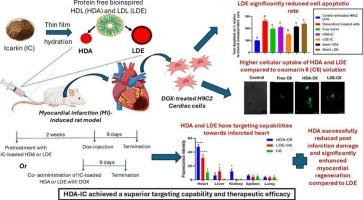HDL and LDL-bioinspired nanocarriers in acellular targeted delivery of Icariin for cardiac repair post myocardial infarction
IF 4.3
2区 医学
Q1 PHARMACOLOGY & PHARMACY
European Journal of Pharmaceutics and Biopharmaceutics
Pub Date : 2025-07-22
DOI:10.1016/j.ejpb.2025.114816
引用次数: 0
Abstract
Myocardial infarction (MI) is a major ischemic heart condition that leads to the loss of billions of cardiomyocytes, triggering adverse ventricular remodeling and fibrotic tissue formation, which can ultimately result in heart failure. Current treatments fail to address cardiomyocyte loss, prompting interest in cardiac regeneration strategies. Although cell-based therapies have gained attention, they face limitations such as poor cell survival and engraftment. Acellular nanoformulations represent a promising alternative. In this study, protein-free bioinspired lipid nanoparticles mimicking low- and high-density lipoprotein; LDL and HDL—namely LDE and HDA—were developed and loaded with the phytomedicine Icariin. Both systems demonstrated high encapsulation efficiency (>90 %), favorable drug release profiles, and good serum stability. In vitro, LDE and HDA exhibited superior cellular uptake in H9c2 cells and significantly improved cell viability in doxorubicin-treated cultures compared to free Icariin. Pretreatment with LDE-Icariin effectively reduced cardiomyocyte apoptosis following doxorubicin exposure. Biodistribution analysis revealed enhanced targeting of infarcted myocardium by HDA over LDE in a rat MI model. Moreover, HDA markedly reduced cardiac damage and promoted regeneration more effectively than LDE. These findings highlight HDA and LDE as cost-effective, bioinspired nanoformulations for cardiac repair, with HDA showing superior targeting and therapeutic performance.

以高密度脂蛋白和低密度脂蛋白为灵感的纳米载体,非细胞靶向递送淫羊藿苷用于心肌梗死后的心脏修复
心肌梗死(MI)是一种主要的缺血性心脏病,可导致数十亿心肌细胞的损失,引发不利的心室重塑和纤维化组织形成,最终可导致心力衰竭。目前的治疗方法不能解决心肌细胞的损失,促使人们对心脏再生策略的兴趣。尽管基于细胞的治疗方法已经引起了人们的关注,但它们面临着诸如细胞存活率和植入性差等局限性。无细胞纳米制剂是一种很有前途的替代方案。在这项研究中,无蛋白生物激发脂质纳米颗粒模拟低脂蛋白和高密度脂蛋白;制备了低密度脂蛋白和高密度脂蛋白,即低密度脂蛋白和高密度脂蛋白,并将植物药淫羊藿苷负载。两种系统均具有较高的包封效率(90%)、良好的药物释放特性和良好的血清稳定性。在体外,与游离淫羊藿苷相比,LDE和HDA在H9c2细胞中表现出更好的细胞摄取,并显著提高了阿霉素处理的培养细胞的活力。lde -淫羊藿苷预处理可有效减少阿霉素暴露后心肌细胞凋亡。生物分布分析显示HDA对心肌梗死的靶向作用强于LDE。此外,HDA比LDE更有效地减少心脏损伤和促进心脏再生。这些发现强调HDA和LDE是具有成本效益的、生物启发的心脏修复纳米配方,HDA具有优越的靶向性和治疗性能。
本文章由计算机程序翻译,如有差异,请以英文原文为准。
求助全文
约1分钟内获得全文
求助全文
来源期刊
CiteScore
8.80
自引率
4.10%
发文量
211
审稿时长
36 days
期刊介绍:
The European Journal of Pharmaceutics and Biopharmaceutics provides a medium for the publication of novel, innovative and hypothesis-driven research from the areas of Pharmaceutics and Biopharmaceutics.
Topics covered include for example:
Design and development of drug delivery systems for pharmaceuticals and biopharmaceuticals (small molecules, proteins, nucleic acids)
Aspects of manufacturing process design
Biomedical aspects of drug product design
Strategies and formulations for controlled drug transport across biological barriers
Physicochemical aspects of drug product development
Novel excipients for drug product design
Drug delivery and controlled release systems for systemic and local applications
Nanomaterials for therapeutic and diagnostic purposes
Advanced therapy medicinal products
Medical devices supporting a distinct pharmacological effect.

 求助内容:
求助内容: 应助结果提醒方式:
应助结果提醒方式:


